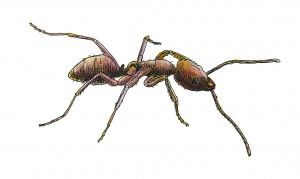READY TO GET STARTED?
REQUEST A FREE ESTIMATE
Fill out the form below or call (888) 466-7849 for a free, no-obligation estimate.
Most likely the ants that are seen during winter are Argentine ants. These ants don’t have to live in the ground; they can make themselves right at home under structures or in the walls of homes protected from the elements. And just a few feet away is everything they need to survive: water, food and shelter. But just think, if the ants are this bad now, imagine how bad they will be in the summer!

Argentine Ant
Argentine ants can quickly populate into multiple colonies containing many queens and thousands of workers. The ants can travel freely between and within these colonies. Due to their fast growth it makes it difficult to control these ants once they have made their way into a structure. People often panic when they see ants inside their home and spray them with the closest can of bug spray that they can find. This might fix the problem temporarily, however, it is best to have a professional who can properly identify the ants and understand their habits in order to devise a treatment plan that will be most effective.
Argentine ants are constantly looking for food. They love sugary foods like soft drinks and syrups. Once an ant finds a food source, it alerts the other ants to “come and get it.” Before you know it the trashcans, counter tops and cabinets are taken over by ants! But don’t worry; there are ways to combat these guys once they have invaded.
While all these methods can be effective, the best way to battle Argentine ants is to keep them from entering homes in the first place. Homeowners can cut limbs and other vegetation away from homes to prevent easy access. Rake fallen leaves and pine straw away from the home. Seal all cracks and entry points around the home (this will help with energy bills as well). Don’t forget about potted plants; ants can even nest under pots!
Many times, the materials we use to make our landscaping aesthetically pleasing are the very materials that will harbor pests. Mulch is not only a favorite material for homeowners to use, but it is also the preferred nesting material for ants – providing moisture and shelter from the elements. If mulch is used next to a house it should be pulled away from the outside walls. Refrain from over-watering mulched areas and limit the depth of the mulch to just a couple of inches to help keep it more dry. The drier the mulch, the less inviting it is for ants and other insects.
Garbage cans are often stored next to houses and buildings for convenience. It also makes the area more attractive to ants and brings them closer to your home. Garbage should be kept in sealed cans that are stored as far away from the home as possible.
Controlling Argentine ants is a difficult, year-round task, but with proper prevention and the help of your pest control provider, it is possible.
Teresa Womack
[email protected]